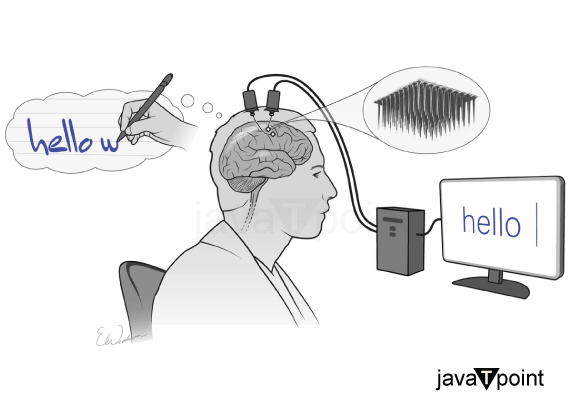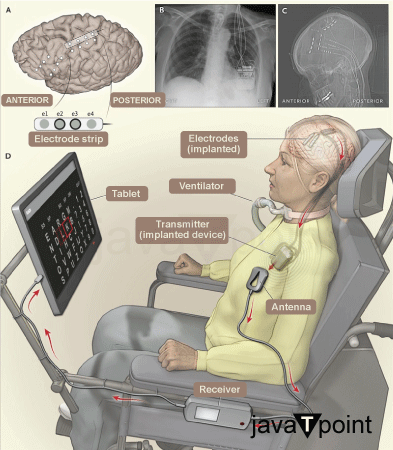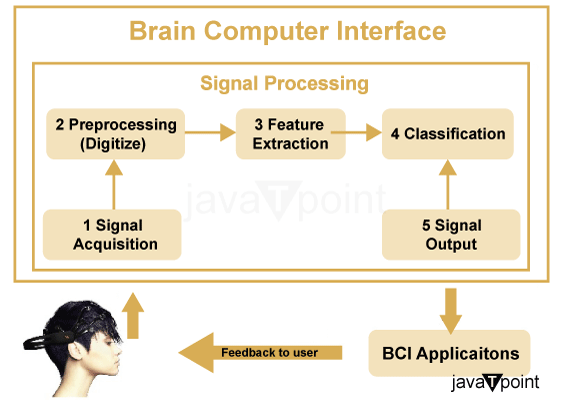Brain-Computer Interface
A brain-machine interface, also referred to as a brain-computer interface (BCI), is a state-of-the-art technology that creates a direct line of communication between the brain and other objects or computer systems. The potential for this ground-breaking interface to revolutionize a wide range of industries, including healthcare, communication, neurology, and assistive technology, is enormous. BCIs hold out the possibility of enhancing human potential and enhancing the quality of life for people with disabilities by bridging the gap between the human brain and digital systems.

Techniques of Brain-Computer Interface System
The way that BCIs work is by identifying and translating brain activity into usable signals that computers or other devices can process. Usually, non-invasive, or invasive techniques are used to gather these signals.

- Non-invasive BCIs: Non-invasive BCIs monitor brain activity without surgery or direct contact with the brain by using external sensors. Electroencephalography (EEG), functional near-infrared spectroscopy (fNIRS), and magnetoencephalography (MEG) are a few examples of these sensors. EEG, for instance, uses electrodes placed on the scalp to record the electrical activity of the brain and convert that activity into data that can be analysed and applied in various ways.
- Invasive BCIs: To more precisely record or stimulate neural activity, invasive BCIs implant electrodes right into the brain tissue. While this method allows for more precise data collection, it also necessitates surgery and carries some risks. BCIs that are intrusive are frequently used in research settings or on patients with serious neurological conditions.
Uses of Brain-Computer Interface
- Assistive Technology: One of the most significant uses of BCIs is in the development of assistive technology for people who have severe motor disabilities or paralysis. These people may be able to operate external devices like computers, robotic arms, or artificial limbs with the help of BCIs. For people who have lost their ability to move, this technology may be able to help them regain their independence and improve their quality of life.
- Enhancement of Communication: BCIs allow people who are unable to communicate verbally because of diseases like locked-in syndrome or amyotrophic lateral sclerosis (ALS) to express themselves by typing or choosing letters on a screen through their brain signals.
- Neurorehabilitation: BCIs are being investigated for neurorehabilitation following a stroke or traumatic brain injury. BCIs can assist patients in relearning motor skills and regaining function in affected limbs by utilizing neural plasticity-the brain's capacity to reorganize itself.
- Cognitive Enhancement: BCIs have the potential to improve mental processes like learning, memory, and attention. The results of this research could improve cognitive training, education, and the treatment of disorders like attention deficit hyperactivity disorder (ADHD).
- Gaming and virtual reality: By enabling users to manipulate avatars or other objects using their brain activity, BCIs can produce immersive experiences in virtual reality settings or video games. The entertainment and interactive industries may change because of this technology.
- Mind-Controlled Devices: BCIs open the door to the possibility of mind-only control of a wide range of devices, from cars to smart home appliances. This might result in more natural and effective interactions with technology.
Components of BCI
BCIs are made up of several essential parts that cooperate to collect, analyze, and act on brain signals. These elements allow neural activity to be converted into actions that have a purpose, bridging the gap between the human brain and digital systems.

- Brain Signal Acquisition System: The system that records brain signals, the electrical or metabolic patterns produced by neural activity. BCIs employ a variety of signal acquisition techniques, such as electrodes inserted into the brain tissue, functional near-infrared spectroscopy (fNIRS), and electroencephalography (EEG), which are non-invasive techniques. The accuracy and dependability of brain signal acquisition are critical to the BCI's overall efficacy.
- Signal processing and feature extraction: The raw brain signals that the acquisition system records are frequently complicated and cluttered. To extract pertinent features that correspond to mental states or intentions, signal processing techniques are used to filter, amplify, and preprocess these signals. The data is improved in this step and made ready for additional analysis.
- Pattern Recognition and Classification: Algorithms for pattern recognition examine the features that were extracted to find patterns connected to various mental states or intentions. Support vector machines (SVMs), neural networks, and Bayesian classifiers are examples of machine-learning techniques that are frequently used to categorize brain signals and decode the user's intended actions or commands.
- Translation and Decoding: Following classification, the BCI translates the patterns into meaningful commands or actions that can be understood by hardware or software programs outside the user's environment. A user's intention to move a particular body part, for instance, might be translated into a corresponding action in motor imagery-based BCIs, such as commanding the movement of a robotic arm.
- Output Devices: Using the decoded brain signals as a guide, output devices execute the intended actions. Computers, robotic arms, artificial limbs, virtual reality environments, and even smart home appliances can be included in this category. BCIs allow users to control these devices without using the usual physical inputs by using their brain activity instead.
- Feedback and adaptation: To inform users of the effectiveness of their commands or actions, BCIs frequently include a feedback mechanism. Users can learn to modulate their brain activity more effectively by using visual, auditory, or tactile feedback, which improves their control over the BCI. Based on user performance and changes in neural patterns, adaptive BCIs can dynamically modify their algorithms.
- Calibration and Training: A BCI must go through a calibration phase before it can correctly decipher a user's intentions. Users perform predetermined tasks or visualize actions while their brain signals are being recorded during calibration. The algorithms of the BCI are trained using this data to recognize the neural patterns of each user. To maximize BCI performance and increase accuracy over time, user training is crucial.
Concept of Electrophysiologic BCIs
Systems for electrophysiologic brain-computer interface (BCI) are at the cutting edge of technological and scientific innovation. These systems make use of the electrical signals produced by neural activity to enable direct communication between the human brain and outside gadgets. The potential of electrophysiologic BCIs to improve human capabilities, transform healthcare, and address issues with disabilities and neurological disorders is enormous.
Recent Advancements in Electrophysiologic BCIs
Signal Acquisition Techniques: Electrophysiologic BCIs use a variety of signal acquisition techniques to record brain activity. Electroencephalography (EEG), one of the most popular methods, records electrical potentials produced by neurons by placing electrodes on the scalp. Recent developments in EEG technology have produced higher-resolution, wireless, and portable EEG systems, improving usability and accessibility.
High-Density Electrode Arrays: High-density EEG electrode arrays offer more accurate spatial resolution of brain signals, enabling better localization of neural activity. These arrays improve the precision of BCI control by allowing the identification of brain regions linked to various tasks or mental states.
Decoding Algorithms: To decode and interpret the intricate patterns of brain signals, machine learning algorithms are essential. Convolutional neural networks, support vector machines, and other cutting-edge algorithms have greatly increased the accuracy of classifying brain patterns and converting them into useful commands.
Real-Time Signal Processing: To enable prompt communication between the user and external devices, real-time signal processing is necessary. The time lag between the user's intention and the device's response has decreased due to recent improvements in computing power and algorithm efficiency.
Challenges and Future Prospects of BCI
BCIs have a lot of potential, but there are still some difficulties:
- Accuracy and Reliability: For BCIs to be successful, it is essential to ensure an accurate and reliable interpretation of brain signals. Reliability may be impacted by background noise, fluctuating brain activity, and the need for calibration.
- User Training: Training and practice are needed to learn how to operate BCIs. To get the results they want, users must learn to modulate their brain activity, which can take time and be difficult.
- Privacy and Ethical Issues: BCIs raise ethical questions about the need for informed consent, the possibility of intrusive data collection, and access to private thoughts.
- Medical Approval and Regulation: As BCIs develop, regulatory organisations must set efficacy and safety requirements to guarantee that these technologies are secure for use by people.
- Long-Term Viability: Implantable BCIs have issues with their durability, the possibility of tissue reactions, and the requirement for upkeep or replacement.
Conclusion
By opening the possibility of direct brain-to-external device communication, brain-computer interfaces represent an incredible integration of the field of neuroscience and technology. BCIs have the potential to change how we interact with technology, improve human capabilities, and provide fresh treatment options for those who suffer from neurological disorders as research and development proceed. Although there are still difficulties, the ongoing developments in BCIs hold the promise of reshaping the limits of human-machine interaction and opening new horizons in the areas of communication, healthcare, and other areas.
|



 For Videos Join Our Youtube Channel: Join Now
For Videos Join Our Youtube Channel: Join Now









